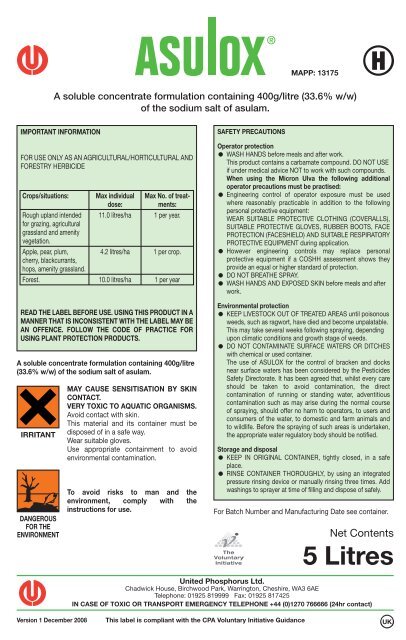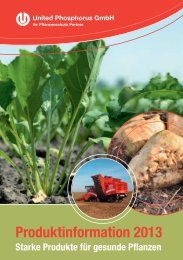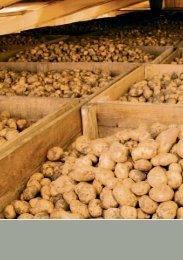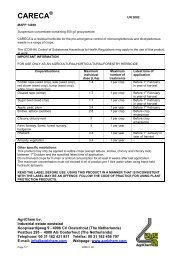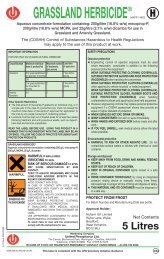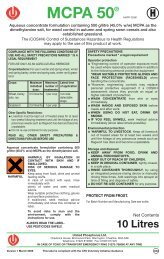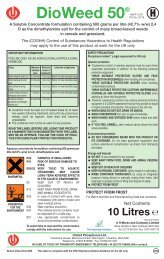H 5 Litres - United Phosphorus Limited
H 5 Litres - United Phosphorus Limited
H 5 Litres - United Phosphorus Limited
Create successful ePaper yourself
Turn your PDF publications into a flip-book with our unique Google optimized e-Paper software.
A soluble concentrate formulation containing 400g/litre (33.6% w/w)<br />
of the sodium salt of asulam.<br />
IMPORTANT INFORMATION<br />
FOR USE ONLY AS AN AGRICULTURAL/HORTICULTURAL AND<br />
FORESTRY HERBICIDE<br />
Crops/situations:<br />
Rough upland intended<br />
for grazing, agricultural<br />
grassland and amenity<br />
vegetation.<br />
Apple, pear, plum,<br />
cherry, blackcurrants,<br />
hops, amenity grassland.<br />
Forest.<br />
A soluble concentrate formulation containing 400g/litre<br />
(33.6% w/w) of the sodium salt of asulam.<br />
IRRITANT<br />
DANGEROUS<br />
FOR THE<br />
ENVIRONMENT<br />
Version 1 December 2008<br />
Max individual<br />
dose:<br />
11.0 litres/ha<br />
4.2 litres/ha<br />
10.0 litres/ha<br />
Max No. of treatments:<br />
1 per year.<br />
1 per crop.<br />
1 per year<br />
READ THE LABEL BEFORE USE. USING THIS PRODUCT IN A<br />
MANNER THAT IS INCONSISTENT WITH THE LABEL MAY BE<br />
AN OFFENCE. FOLLOW THE CODE OF PRACTICE FOR<br />
USING PLANT PROTECTION PRODUCTS.<br />
MAY CAUSE SENSITISATION BY SKIN<br />
CONTACT.<br />
VERY TOXIC TO AQUATIC ORGANISMS.<br />
Avoid contact with skin.<br />
This material and its container must be<br />
disposed of in a safe way.<br />
Wear suitable gloves.<br />
Use appropriate containment to avoid<br />
environmental contamination.<br />
To avoid risks to man and the<br />
environment, comply with the<br />
instructions for use.<br />
<strong>United</strong> <strong>Phosphorus</strong> Ltd.<br />
Chadwick House, Birchwood Park, Warrington, Cheshire, WA3 6AE<br />
Telephone: 01925 819999 Fax: 01925 817425<br />
IN CASE OF TOXIC OR TRANSPORT EMERGENCY TELEPHONE +44 (0)1270 766666 (24hr contact)<br />
This label is compliant with the CPA Voluntary Initiative Guidance<br />
MAPP: 13175<br />
H<br />
SAFETY PRECAUTIONS<br />
Operator protection<br />
WASH HANDS before meals and after work.<br />
This product contains a carbamate compound. DO NOT USE<br />
if under medical advice NOT to work with such compounds.<br />
When using the Micron Ulva the following additional<br />
operator precautions must be practised:<br />
Engineering control of operator exposure must be used<br />
where reasonably practicable in addition to the following<br />
personal protective equipment:<br />
WEAR SUITABLE PROTECTIVE CLOTHING (COVERALLS),<br />
SUITABLE PROTECTIVE GLOVES, RUBBER BOOTS, FACE<br />
PROTECTION (FACESHIELD) AND SUITABLE RESPIRATORY<br />
PROTECTIVE EQUIPMENT during application.<br />
However engineering controls may replace personal<br />
protective equipment if a COSHH assessment shows they<br />
provide an equal or higher standard of protection.<br />
DO NOT BREATHE SPRAY.<br />
WASH HANDS AND EXPOSED SKIN before meals and after<br />
work.<br />
Environmental protection<br />
KEEP LIVESTOCK OUT OF TREATED AREAS until poisonous<br />
weeds, such as ragwort, have died and become unpalatable.<br />
This may take several weeks following spraying, depending<br />
upon climatic conditions and growth stage of weeds.<br />
DO NOT CONTAMINATE SURFACE WATERS OR DITCHES<br />
with chemical or used container.<br />
The use of ASULOX for the control of bracken and docks<br />
near surface waters has been considered by the Pesticides<br />
Safety Directorate. It has been agreed that, whilst every care<br />
should be taken to avoid contamination, the direct<br />
contamination of running or standing water, adventitious<br />
contamination such as may arise during the normal course<br />
of spraying, should offer no harm to operators, to users and<br />
consumers of the water, to domestic and farm animals and<br />
to wildlife. Before the spraying of such areas is undertaken,<br />
the appropriate water regulatory body should be notified.<br />
Storage and disposal<br />
KEEP IN ORIGINAL CONTAINER, tightly closed, in a safe<br />
place.<br />
RINSE CONTAINER THOROUGHLY, by using an integrated<br />
pressure rinsing device or manually rinsing three times. Add<br />
washings to sprayer at time of filling and dispose of safely.<br />
For Batch Number and Manufacturing Date see container.<br />
Net Contents<br />
5 <strong>Litres</strong><br />
UK
DIRECTIONS FOR USE<br />
IMPORTANT: This information is approved as part of the product label. All instructions within this section must be read carefully in order to obtain safe and successful use of this product.<br />
The following directions for use are set out as below:<br />
PART ONE: Bracken Control<br />
A. Rough upland intended for grazing, agricultural grassland and amenity vegetation<br />
B. Forestry Areas<br />
PART TWO: Dock Control<br />
A. Permanent pasture, established leys, hayfields and silage leys.<br />
B. Amenity grassland, roadside verges, waste ground and amenity areas (excluding fine turf).<br />
C. Established Orchards,(Apple,Pear, Plum, Cherry) and Established Blackcurrants and Hops.<br />
PART ONE: BRACKEN CONTROL<br />
RESTRICTIONS<br />
Spray ASULOX at or just before full frond extension (minimum 3 ‘pairs’ of ‘leaves’) and before senescence<br />
DO NOT apply during or immediately after drought periods or in conditions of high temperature and low humidity.<br />
The use of the red feed nozzle for ‘Micron Ulva’ application is restricted to forestry use where bracken suppression only is required.<br />
The fronds must not be damaged by livestock, frost or by cutting before treatment. Do not treat bracken affected by late frosts (bronzed and stunted fronds).<br />
At least 6 weeks should elapse between applying ASULOX and sowing or planting any subsequent crop.<br />
DO NOT cut the bracken or admit livestock for at least 14 days after spraying and preferably leave it undisturbed until late autumn. This is to allow adequate translocation of ASULOX within<br />
the bracken plant<br />
Additives should not be used in forestry situations.<br />
In order to qualify for EU or Governmental grants it may be necessary to undertake some form of after-care involving one or all of the follow-up bracken treatments (i.e. liming, fertilizing or<br />
re-seeding). The requirements for grant aid vary locally; therefore, contact either your local ADAS or DAFS office about the eligibility and requirements for grant aid before commencing work.<br />
TREATMENT INFORMATION<br />
Apply on a dry day. Bracken should be treated in full frond (all fronds fully expanded) but before yellowing (start of senescence).<br />
Normally this will be within the period from early July to late August (early August in Northern Britain). Senescence begins with the fronds turning a darker green, becoming glossy and hard to<br />
the touch, with subsequent bronzing.<br />
ASULOX may be applied in water with or without ‘Agral’, or ‘High Trees Non-Ionic Wetter’, or in mixture with ADDER or ‘Actipron’. These additives increase the rate of uptake of ASULOX by<br />
the bracken fronds thereby improving reliability under adverse climatic conditions.<br />
Herbicidal symptoms are virtually absent in the year of spraying but in the following season there is little or no frond re-growth.<br />
Follow up treatments:<br />
Owing to the nature of bracken growth and the difficulty of spraying sheltered or uneven terrain, 100% control is rarely achieved. Any bracken surviving should be sprayed as soon as it<br />
recovers to full green frond. This may be the year following the initial application but more likely the second year following initial application. If a programme of follow-up sprays is undertaken<br />
the bracken-free period will be greatly extended.<br />
IF NO FOLLOW-UP TREATMENT OR LAND IMPROVEMENT PROGRAMME IS CARRIED OUT, RESPRAYING MAY BE NECESSARY WITHIN 5 YEARS.<br />
MIXING<br />
a. Water Based Systems<br />
Half fill the spray tank or container with water and then pour in the required amount of ASULOX. Top up with water then add ‘Agral’or ‘High Trees Non-Ionic Wetter’ where this is being used.<br />
Ensure thorough mixing before commencing spraying.<br />
b. Oil Based Systems:<br />
ASULOX and ADDER or ‘Actipron’:<br />
Mix ASULOX and ADDER or ‘Actipron’ thoroughly before filling the spray tank. No water is required.<br />
CROP SPECIFIC INFORMATION<br />
Only one application should be made per crop/situation per year.<br />
A. Rough upland intended for grazing, agricultural grassland and amenity vegetation<br />
Effect on the sward<br />
Some grasses and herbs will be damaged by the full dose. In practice, the bracken canopy protects the sward and any check to these species is only temporary. The more sensitive species include<br />
Yorkshire-fog, Timothy, Cock’s-foot, bents, annual meadow-grass, daisy, docks, plantains and saxifrage.<br />
Effects on trees and shrubs<br />
Most species are unaffected. However, young specimens of the following may exhibit chlorosis and a slight check in growth if directly sprayed whilst actively growing:<br />
Beech<br />
Bilberry<br />
Birch<br />
Corsican pine<br />
Douglas fir<br />
Elm<br />
Gorse<br />
Grand fir<br />
Heathers<br />
Japanese larch<br />
Mature specimens of the above, as well as hawthorn, holly and rowan will be unharmed.<br />
Western hemlock and willows are more susceptible and spraying of these species should be avoided.<br />
Aerial application by helicopter<br />
NB. Fixed wing aircraft are not recommended for the application of<br />
ASULOX to bracken.<br />
It is essential to determine swath width before spraying. Ground<br />
markers should be used where possible to aid swath<br />
matching.<br />
Tractor mounted sprayer<br />
Hand-operated knapsack sprayer<br />
DO NOT use this method of application where bracken exceeds<br />
waist height as coverage and ultimately, control, will be impaired.<br />
Spot treatment with knapsack or hand-lance<br />
Low volume drift-spraying with ‘Micron Ulva’<br />
Norway spruce<br />
Poplar<br />
Scots pine<br />
Sitka spruce<br />
a. Conventional water-based system:<br />
Mix 11.0litres of ASULOX in 44L water/ha with ‘Agral’ or ‘High Trees Non-Ionic Wetter’ at a rate of 100mL/l00 litres of spray<br />
solution. Application can be made with either conventional or Delavan ‘Raindrop’ nozzles. ‘Raindrop’ nozzles give larger<br />
droplets which lessen the risk of drift or evaporation.<br />
b. Low volume oil-based system:<br />
Mix 11.0 litres of ASULOX with 7 litres of ‘Adder’ (or ‘Actipron’) and 2.0L water/ha. Delavan ‘Raindrop’ nozzles are necessary.<br />
Use ASULOX at a rate of 11L/ha in 400 - 500 L water/ha as a MEDIUM or COARSE spray (BCPC category). Adjust boom<br />
height to give uniform coverage at the top of the bracken fronds.<br />
Use ASULOX at 11 L/ha in 50 - 200 L water/ha with ‘Agral’ or ‘High Trees Non-Ionic Wetter’ at the rate of 1.0ml/L<br />
of spray solution. The knapsack lance should be fitted with a boom and nozzles to apply a MEDIUM or COARSE spray<br />
(BCPC category).<br />
Mix 10 parts ASULOX and 1 part ‘Agral’ or ‘High Trees Non-Ionic Wetter’ with 1000 parts water (see ‘Guide to Dilution<br />
Rates’). Use an HC/0.4/3 nozzle (BCPC code) and apply spray to the point of run-off. Where calibrated spot-guns are used,<br />
especially in treatment of re-growth apply 2.5 ml per frond. To help identify treated fronds a red food dye may be mixed<br />
with the spray at a concentration of 0.1%.<br />
Use ASULOX at 11 L/ha with ‘Adder’ or ‘Actipron’ at 7.0 L/ha. Apply a total of 18 L/ha.<br />
(refer to the section Spraying Procedure for the ‘Micron Ulva’)
Spraying Procedure for the ‘Micron Ulva’<br />
Spraying with a ‘Micron Ulva’ requires close attention to detail and to the method of spraying. The best results will be obtained when the work is carried out carefully, methodically and accurately. In<br />
order to drift the spray mixture on to the bracken there must be a steady wind of 5 - 25 km/hr (3-15mph or Force 1-4 on the Beaufort Scale) over the area to be sprayed. DO NOT treat when the wind<br />
is gusty or changeable in direction. For ease of spraying on steep hillsides it is desirable to spray along the contours. Consequently the wind should be blowing up or down the slope.<br />
Accurate marking of the swaths with brightly coloured canes or flags should be carried out in every case. If the bracken is dense, it may be necessary to walk along the swath lines before spraying<br />
to establish a relatively free path. Start spraying 3 metres inside the downwind edge. Walk through the bracken at right angles to the wind holding the head of the ‘Micron Ulva’ approximately one<br />
metre above the top of the bracken. The spray head should always be held downwind of the operator with the face away from the operator. The feed bottle should be held vertical. The operator should<br />
walk at 1 metre every 3 seconds when using the grey feed-nozzle and 1 metre every 11 /2 seconds when using the green feed-nozzle.<br />
On reaching the far edge of the bracken, move 3 metres into the wind and return across the area. Continue spraying in this manner using passes every 3 metres through the bracken and using the<br />
canes or flags as swath markers until the area to be sprayed has been covered.<br />
Feed<br />
Nozzle<br />
Colour<br />
Grey<br />
Green<br />
Nominal Flow<br />
Rate of<br />
Mixture<br />
(mL/sec)<br />
2<br />
4<br />
Metres/<br />
minute<br />
Required Walking Speed<br />
using a 3m swath<br />
DO NOT USE the red feed nozzle for non-forestry application<br />
NB: As a check on application, a 0.5 litre bottle should be emptied in about 90 metres or paces. One full ‘Micron Ulva’ bottle (1 litre) will treat approximately 550 square metres.<br />
After use the feed nozzle should always be washed out with water to prevent subsequent blockage. Batteries for the ‘Micron Ulva’ should be replaced after five hours use.<br />
NO OTHER APPLICATION MACHINERY OR METHODS ARE RECOMMENDED FOR THE APPLICATION OF ASULOX TO BRACKEN.<br />
B. Forestry Areas<br />
Areas to be used for new plantings:<br />
These should be treated during the summer prior to planting, and then planted up in accordance with normal practice for the district.<br />
Areas to be replanted:<br />
Spraying should be carried out in standing timber before clearing. If clear felling is carried out in the spring, the cleared areas can be sprayed in the summer as for new plantings. However, possible<br />
damage to emerging bracken from clear felling operations may lead to variable long-term control and some re-growth in the following year is likely.<br />
Newly planted areas:<br />
Two methods of use may be employed.<br />
1. Bracken may be ‘whipped’ or cut early in the season and ASULOX applied to the re-growth later. This effectively means that by the time the spraying is carried out, growth has ceased on most<br />
tree species and the risk of any check removed.<br />
2. ASULOX may be applied overall to the undisturbed canopy. In either case, due to the relatively insignificant effect of ASULOX on the frond growth during the season of application, the bracken<br />
will inevitably have to be cut before the end of the season to prevent collapse on to the young trees. An interval of at least fourteen days should elapse between spraying and cutting.<br />
Forestry Application only:<br />
The rate of ASULOX applied will depend upon the period of protection or release from bracken required. NO ADDITIVES SHOULD BE USED IN FORESTRY SITUATIONS<br />
Planting Programmes<br />
Pre-planting:<br />
Leave bracken undisturbed until it dies back, then plant up in accordance with normal forestry practice.<br />
Post-planting:<br />
See ‘EFFECTS ON TREES AND SHRUBS’ on page 4. Allow at least 14 days between application and cutting or clearing bracken from small trees.<br />
GUIDE TO DILUTION RATES:<br />
For bracken use a standard dilution of 1 part ASULOX to 100 parts water<br />
22<br />
44<br />
COMPATIBILITY<br />
The use of products other than those adjuvants or wetters listed for the various methods of application is not recommended.<br />
PART TWO - DOCK CONTROL<br />
RESTRICTIONS<br />
Ragwort may become more palatable to grazing livestock, therefore, livestock must be denied access to the treated areas for at least 4 to 6 weeks or until the ragwort has died and become<br />
unpalatable.<br />
DO NOT treat docks during the winter months, i.e October to March inclusive; do not treat once the flowering stem starts to emerge or at the flowering stage.<br />
The action of ASULOX against docks is relatively slow. Herbicidal symptoms are yellowing of the leaves and any re-growth will appear red and distorted. Normally these symptoms do not<br />
appear until 3 weeks after treatment, the full effect may not become apparent until 6 months after treatment.<br />
If over-grazing or poaching takes place after treatment, heavy infestations of dock seedlings can occur. They will be susceptible to ASULOX.<br />
DO NOT treat grassland or leys in the year of establishment<br />
Seconds/<br />
pace<br />
3<br />
1 1 /2<br />
1 acre<br />
1 hour<br />
1 /2 hour<br />
Time Taken to spray<br />
1 hectare<br />
2 1 /2 hours<br />
1 1 /4 hours<br />
Tractor mounted sprayer<br />
Apply 5 - 10 L/ha of ASULOX in 200 - 300 L/ha of water as a MEDIUM or COARSE spray (BCPC category).<br />
Hand-operated knapsack or motorised mist Apply 5 - 10 L/ha of ASULOX in 90 - 175 L/ha of water.<br />
blower<br />
Where booms and nozzles are used a MEDIUM or COARSE spray (BCPC category) should be applied.<br />
Spot treatment with knapsack or hand-lance Mix 1 part ASULOX with 100 parts water (see Guide to Dilution Rates) below.<br />
Low volume drift spraying with the ‘Micron Apply neat ASULOX at 5 - 10 L/ha using the red feed-nozzle and at a walking speed of 1 pace per second. Use a swath of not more than<br />
Ulva’<br />
3 metres wide, or direct the spray cloud over tree rows.<br />
Aerial (Helicopter)<br />
NB. Fixed wing aircraft are not recommended for<br />
the application of ASULOX<br />
Apply 5 - 10 L/ha of ASULOX in a total volume, including water, of 55L/ha. Use either Delavan ‘Raindrop’ or conventional nozzles.<br />
Sprayer capacity<br />
(<strong>Litres</strong>)<br />
5<br />
7<br />
12<br />
20<br />
Knapsack Sprayer:<br />
Volume of ASULOX<br />
(mls)<br />
50<br />
70<br />
120<br />
200<br />
Sprayer capacity<br />
(<strong>Litres</strong>)<br />
200<br />
250<br />
400<br />
500<br />
Standard Sprayer with Hand-lance:<br />
Volume of ASULOX<br />
(<strong>Litres</strong>)<br />
2.0<br />
2.5<br />
4.0<br />
5.0
WEEDS CONTROLLED<br />
For best results treat when the plants are actively growing and IN FULL LEAF but before any signs of emergence of flower stems.<br />
This is normally between April and September. If the flower stems have emerged, mow them off and treat the leafy regrowth. If cutting, grazing or poaching has taken place, the docks must<br />
be allowed to recover adequate foliage before applying ASULOX. In any event do not apply ASULOX within three weeks of cutting to give time for the docks to recover and to avoid sward<br />
damage from applications made too soon after a cut.<br />
DO NOT graze or mow for at least one week after application to allow time for the ASULOX to be translocated within the docks.<br />
For light or recently established infestations, one application of ASULOX should be sufficient. For heavy or long established infestations two applications, at least ten months apart, are<br />
recommended.<br />
Always carry out any second treatment in the season following the initial application.<br />
Hay Fields: DO NOT USE ASULOX BEFORE MOWING FOR HAY<br />
ASULOX does not impart toxic properties to hay. However, there may be a short-term loss of bulk due to control of the docks and the presence of sensitive grass species. These include bents<br />
(Agrostis spp), meadow-grass (Poa spp), Yorkshire-fog, creeping Soft-grass (Holcus spp), and the brome grasses (Bromus spp).<br />
Silage Leys:<br />
Spray fields destined for silage production within 7 - 10 days prior to a cut - provided the cutting date can be predetermined with accuracy. If not, spray 3 weeks after the final cut, having allowed adequate<br />
re-growth of the docks, but in any event, not later than mid-August. This avoids loss of bulk of treated grasses which would occur if cutting were delayed until after spraying, or alternatively,<br />
avoids sward damage from spraying too soon after cutting silage.<br />
Effect on grasses and clovers:<br />
Established rye-grasses can safely be treated with ASULOX when used as directed. When ASULOX is used on bents, fescues, meadow-grasses and Timothy swards, with or without rye-grasses, application<br />
may be followed by yellowing and a temporary check to growth. Cock’s-foot and Yorkshire-fog may be severely checked. Established clovers are practically unaffected by ASULOX but seedlings<br />
may be damaged. In hayfields and silage leys, ASULOX will not cause any loss of bulk if used as advised. However, if used outside the recommendation, some loss of bulk may be experienced.<br />
CROP SPECIFIC INFORMATION<br />
Only one application should be made per crop/situation each year.<br />
A. Permanent pasture, established leys, hayfields and silage leys<br />
Do not treat grassland or leys in year of establishment.<br />
Standard Crop Sprayer<br />
Knapsack sprayer (spot treatment)<br />
Apply 2.8 L/ha ASULOX in 200 L/ha of water using a MEDIUM or COARSE spray (BCPC category). Take care that the sprayed swaths do not overlap.<br />
See ‘Guide to Dilution Rates’ on page 8. Use a standard dilution of 1 part ASULOX in 200 parts of water but avoid spraying to run-off. Apply spray<br />
with an HC/0.4/3 nozzle (BCPC code). To identify treated plants, a red food dye may be mixed with the spray at aconcentration of 0.1%.<br />
B. Amenity grassland, roadside verges, waste ground and amenity areas (excluding fine turf).<br />
Standard Crop Sprayer<br />
Apply 4.2 L/ha ASULOX in 200-400 L/ha of water using a MEDIUM or COARSE spray (BCPC category)<br />
Knapsack sprayer or Standard Crop See ‘Guide to Dilution Rates’ on page 8. Use a standard dilution of 1 part of ASULOX to 200 parts of water but avoid spraying to ‘run off’. Apply<br />
Sprayer fitted with hand-lance at- spray with an HC/0.4/3 nozzle (BCPC code).<br />
tachment<br />
To identify treated plants, a red food dye may be mixed with the spray at a concentration of 0.1%.<br />
C. Established Orchards, (Apple, Pear, Plum, Cherry) and Established Blackcurrants and Hops.<br />
Do not apply directly to these crops<br />
Use ASULOX as a directed spray around the base of the plants, where treatment adjacent to a crop is required. Use same rates as above.<br />
Do not treat blackcurrant cuttings, hop sets or ‘weak’ hills.<br />
GUIDE TO DILUTION RATES:<br />
FOR DOCKS - 1 part ASULOX to 200 parts water.<br />
Sprayer capacity<br />
(<strong>Litres</strong>)<br />
5<br />
7<br />
12<br />
20<br />
Knapsack Sprayer:<br />
FOLLOWING CROPS<br />
At least 6 weeks should elapse between applying ASULOX and sowing or planting any subsequent crop.<br />
MIXING<br />
Half fill the spray tank or container with water and then pour in the required amount of ASULOX. Top up with water ensuring thorough mixing before spraying. Always adjust the spray machine or direct<br />
the appliance to give uniform coverage at the height of the docks.<br />
COMPATIBILITY<br />
ASULOX may be tank-mixed with the following products for the control of docks and other broad-leaved weeds.<br />
To control creeping buttercup, creeping thistle and or plantains:<br />
To control chickweed:<br />
Volume of ASULOX<br />
(mls)<br />
25<br />
35<br />
60<br />
100<br />
Sprayer capacity<br />
(<strong>Litres</strong>)<br />
An approved formulation of an MCPA Salt, e.g. ‘Agritox 50’.<br />
An approved formulation of a mecoprop salt, e.g. ‘Compitox Extra’.<br />
Only ASULOX + BELLMAC PLUS is safe for use on grassland with clover.<br />
CONDITIONS OF SUPPLY<br />
All goods supplied by us are of high grade and we believe them to be suitable but, as we cannot exercise control over their storage, handling, mixing or use, or the weather conditions before, during<br />
and after application which may affect the performance of the goods, all conditions and warranties, statutory or otherwise, as to the quality or fitness for any purpose of our goods are excluded, and<br />
no responsibility will be accepted by us or re-sellers for any failure in performance, damage or injury whatsoever arising from their storage, handling, application or use. Our staff or agents cannot vary<br />
these conditions whether or not they supervise or assist in the use of such goods.<br />
ASULOX is a trademark of <strong>United</strong> <strong>Phosphorus</strong> <strong>Limited</strong>. Other brand names used in this guide are trademarks of other companies for which proprietary rights may exist.<br />
200<br />
250<br />
400<br />
500<br />
Standard Sprayer with Hand-lance:<br />
Volume of ASULOX<br />
(<strong>Litres</strong>)<br />
1.00<br />
1.25<br />
2.00<br />
2.50


